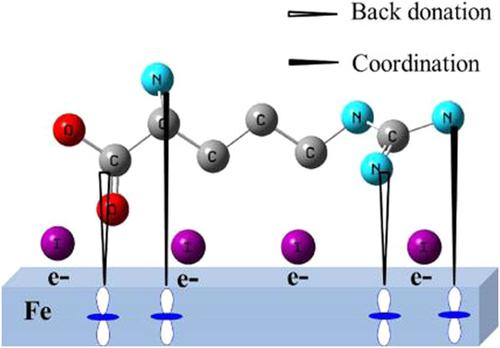当前位置:
X-MOL 学术
›
Mater. Corros.
›
论文详情
Our official English website, www.x-mol.net, welcomes your
feedback! (Note: you will need to create a separate account there.)
Corrosion inhibition of amino acids for 316L stainless steel and synergistic effect of I− ions: Experimental and theoretical studies
Materials and Corrosion ( IF 1.6 ) Pub Date : 2021-08-06 , DOI: 10.1002/maco.202112511 Rongxuan Zhao 1 , Qian Yu 1 , Lin Niu 1
Materials and Corrosion ( IF 1.6 ) Pub Date : 2021-08-06 , DOI: 10.1002/maco.202112511 Rongxuan Zhao 1 , Qian Yu 1 , Lin Niu 1
Affiliation

|
The inhibition effect of amino acids l-lysine (Lys) and l-arginine (Arg), which serve as inhibition films for corrosion of 316L stainless steel in 0.5 M NaCl solution, is studied by electrochemical measurements. The adsorption of the inhibitor molecules on the steel surface is studied by Fourier transformed infrared spectroscopy (FTIR) and surface-enhanced Raman spectroscopy (SERS), accompanied by the characterization of the metal surface by scanning electron microscopy (SEM). All in all, Lys or Arg can obviously restrain the corrosion of 316L steel, while the inhibition efficiency is even higher with the assistance of I− ions. Arg always has better inhibition performance than Lys regardless of the addition of I− ions. FTIR and SERS confirm the adsorption of amino acids on the metal surface; at the same time, the morphology and protection effect of the inhibition films is clearly illustrated via SEM images. Thanks to all experimental measurements as mentioned above and theoretical calculations, a mechanism model is proposed to simulate the corrosion inhibition process of amino acids and the synergistic effect of I− ions on 316L steel.
中文翻译:

氨基酸对 316L 不锈钢的腐蚀抑制及 I− 离子的协同作用:实验和理论研究
通过电化学测量研究了氨基酸l-赖氨酸 (Lys) 和l-精氨酸 (Arg) 作为 316L 不锈钢在 0.5 M NaCl 溶液中腐蚀的抑制膜的抑制作用。通过傅里叶变换红外光谱 (FTIR) 和表面增强拉曼光谱 (SERS) 研究了抑制剂分子在钢表面上的吸附,同时通过扫描电子显微镜 (SEM) 对金属表面进行了表征。总而言之,Lys或Arg对316L钢的腐蚀有明显的抑制作用,而在I -离子的辅助下抑制效率更高。无论是否添加 I,Arg 始终具有比 Lys 更好的抑制性能-离子。FTIR 和 SERS 证实了氨基酸在金属表面的吸附;同时,通过SEM图像清楚地说明了抑制膜的形态和保护作用。由于上述所有的实验测量和理论计算,提出了一个机理模型来模拟氨基酸的腐蚀抑制过程和 I -离子对 316L 钢的协同作用。
更新日期:2021-08-06
中文翻译:

氨基酸对 316L 不锈钢的腐蚀抑制及 I− 离子的协同作用:实验和理论研究
通过电化学测量研究了氨基酸l-赖氨酸 (Lys) 和l-精氨酸 (Arg) 作为 316L 不锈钢在 0.5 M NaCl 溶液中腐蚀的抑制膜的抑制作用。通过傅里叶变换红外光谱 (FTIR) 和表面增强拉曼光谱 (SERS) 研究了抑制剂分子在钢表面上的吸附,同时通过扫描电子显微镜 (SEM) 对金属表面进行了表征。总而言之,Lys或Arg对316L钢的腐蚀有明显的抑制作用,而在I -离子的辅助下抑制效率更高。无论是否添加 I,Arg 始终具有比 Lys 更好的抑制性能-离子。FTIR 和 SERS 证实了氨基酸在金属表面的吸附;同时,通过SEM图像清楚地说明了抑制膜的形态和保护作用。由于上述所有的实验测量和理论计算,提出了一个机理模型来模拟氨基酸的腐蚀抑制过程和 I -离子对 316L 钢的协同作用。











































 京公网安备 11010802027423号
京公网安备 11010802027423号